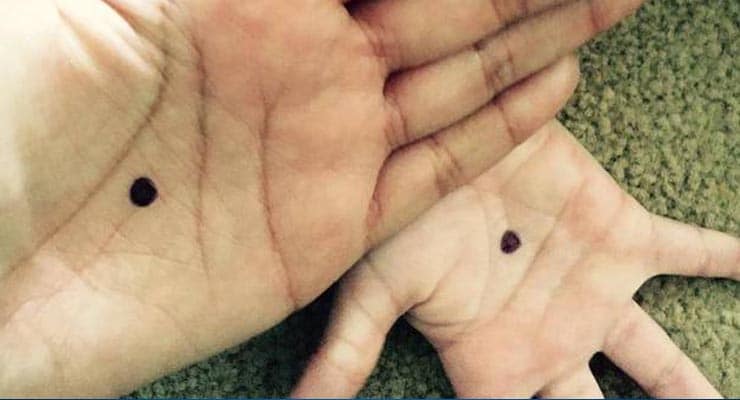The Black Dot Campaign – Fact Check
Messages are circulating on the Internet that describe the “black dot campaign” where victims of domestic abuse can covertly request help by drawing a black dot onto the palm of their hands.
An example of the message can be seen below –
If a woman ever opens her hand to you and shows you a black dot in its center, she is a victim of domestic violence and she desperately needs help – right NOW. She can’t say anything and she can’t let on because her abuser is near and watching her like a hawk. I’m glad I know this now.
TLDR: The Black Dot Campaign is real to the extent that in 2015 a number of social media users pushed the concept of requesting professional help by placing a black dot in the palm of your hand. However it is not an official program and professionals are not trained to look for a black dot or understand what one would mean. Additionally, the concept has some serious flaws and the campaign organisers concede this isn’t a solution for everyone. The campaign has not been widely promoted for a number of years now.
The Black Dot Campaign first began spreading prolifically on social media back in 2015, and many messages connected to the campaign asserted that it was a method for victims of domestic abuse to surreptitiously ask for help without alerting their abuser.
Sponsored Content. Continued below...
While the idea is certainly well-meaning, it is not without its flaws. Firstly and perhaps most importantly, this isn’t an official program or a recognised method of seeking help. The campaign isn’t officially supported nor endorsed by any relevant entity, such as hospitals or authorities, and as such professionals such as doctors or police officers are not trained to look for a black dot, nor would they likely know what it means if they did find one.
This was confirmed by the campaign organisers in 2015 who asserted the concept came from a victim of domestic abuse.
The original ethos for this campaign was to enable a victim to put a dot on their hand around someone they trusted to enable a conversation to start, so they could open that door and hopefully start a process of seeking professional help.
This is an idea, thinking outside of the box, trying to open up the worlds eyes and ears to what is going on in terms of abuse. The idea came from a former domestic violence victim.
Professional bodies have not been advised or trained in the Black Dot, what it symbolises and what it means
The organisers also stated that the Black Dot Campaign was a method of “raising awareness” to the issues of domestic violence, and it was not a solution that will help everyone.
When people contact us we open the gates of communication and put them in touch with people who can really help.
Putting such a campaign on Facebook was about raising awareness on a social media platform
This isn’t the solution that will help everyone, if anything it should help people realise what abuse is, how it affects people and how to access help.And most importantly SAFETY MUST ALWAYS COME FIRST. If you see a black dot or are approached by someone for help, if safe to do so take them to safety and get them in contact with the relevant agency. Intervention and support should only be done by professionals
Perhaps one of the more noticeable flaws in the concept is that first and foremost it is typically presented as a covert or secretive way for domestic abuse victims to request help without alerting their abusive partner.
Now, while this may or may not have been the primary idea behind the campaign, it should be pointed out that since it has spread prolifically on social media, the abusive person in a relationship it just as likely to have seen it as their partner, meaning a black dot could perhaps compound a potentially volatile situation if the abusive partner questions the black dot, or worse, understands what it is supposed to symbolise.
Sponsored Content. Continued below...
Another potential issue is that because the Black Dot Campaign is not an officially recognised or widely adopted program, victims of domestic abuse may ill-advisedly rely on the black dot instead of finding more reliable ways of requesting help. Since most professionals are not likely to understand what the black dot means, this may lead to a delay in the domestic abuse victim receiving vital help.
Additionally, and finally, the Black Dot Campaign hasn’t been substantially pushed or promoted by its organisers since around 2015 when it first gained popularity amidst the above criticism.
While the intentions of the Black Dot Campaign are well-meaning, it isn’t a reliable method of getting help and certainly one that will not be appropriate or even safe for many victims of domestic abuse.
Keep up-to-date with all our latest articles. Follow us on Facebook, Instagram and Twitter.
Continued below...
Thanks for reading! But before you go… as part of our latest series of articles on how to earn a little extra cash using the Internet (without getting scammed) we have been looking into how you can earn gift vouchers (like Amazon vouchers) using reward-per-action websites such as SwagBucks. If you are interested we even have our own sign-up code to get you started. Want to learn more? We discuss it here. (Or you can just sign-up here and use code Nonsense70SB when registering.)
Become a Facebook Supporter. For 0.99p (~$1.30) a month you can become a Facebook fan, meaning you get an optional Supporter Badge when you comment on our Facebook posts, as well as discounts on our merchandise. You can subscribe here (cancel anytime.)
